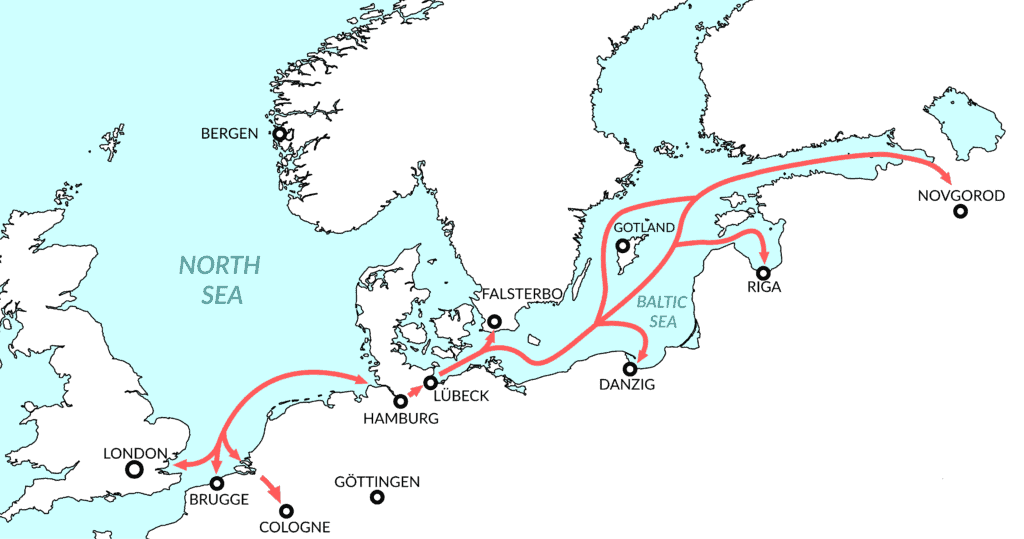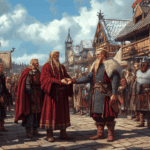
The Hanseatic League, often referred to as die Hanse, was the most influential medieval commercial network in Northern Europe, eventually rising to dominance in Baltic and North Sea trade.
Origins
The roots of the Hanseatic League can be traced back to the rebuilding of Lübeck in 1159 by Henry the Lion, Duke of Saxony and Bavaria. Lübeck had been destroyed by fire in 1157, but its reconstruction marked a turning point in regional commerce. Henry’s Artlenburger Privileg treaty of 1161 granted Lübeck merchants equal rights with Gotland traders, who had previously dominated Baltic trade. This legal framework laid the foundation for Lübeck’s emergence as a central trading hub.
Lübeck’s geographical position was ideal—it connected the Baltic Sea with inland trade routes leading to Saxony and Westphalia. Merchants from these regions began using Lübeck as a transshipment port for goods moving between the North Sea and Baltic regions. The city also benefited from imperial privileges, becoming a free imperial city in 1226 under Valdemar II of Denmark. These developments made Lübeck an attractive center for merchants seeking legal protections and access to lucrative markets.
The Role of Merchant Guilds and Early Alliances

The Hanseatic League was born out of necessity. In an era marked by piracy, unstable political conditions, and local feudal interference, individual merchants faced significant risks. To counter these challenges, guilds began forming associations known as hansas—a term derived from a Gothic word meaning “troop” or “company”. These guilds pooled resources to protect their members’ goods, negotiate trade privileges, and ensure mutual defense.
One of the earliest documented instances of such cooperation occurred between 1173 and 1175 in London. Merchants from Cologne successfully persuaded King Henry II of England to exempt them from tolls and grant protection for their goods across England. This marked a significant milestone in the development of organized trade networks among German merchants.

Expansion Through Strategic Alliances
The consolidation of merchant guilds into larger associations accelerated during the 13th century. In 1241, Lübeck formed an alliance with Hamburg, combining their control over salt and fish trade routes. This partnership monopolized key commodities essential for medieval economies. By 1260, Cologne joined this alliance, further strengthening its influence over Western European markets.
During this period, German cities also expanded their reach into Eastern Europe. Colonists established settlements along the Baltic coast in cities like Riga, Tallinn (Reval), and Danzig (Gdańsk). These cities adopted Lübeck law, which provided standardized legal frameworks for trade disputes and governance. This legal uniformity facilitated smoother commerce across vast distances.
Political Independence and Economic Autonomy
One distinguishing feature of Hanseatic cities was their relative independence from feudal authorities. Unlike other medieval towns subject to local dukes or electors, Hanseatic cities operated autonomously within the Holy Roman Empire. This autonomy allowed them to focus exclusively on trade without interference from petty nobles demanding tribute.
For example, Lübeck’s merchants were granted free trade rights under Henry the Lion’s policies. Similarly, Hamburg received privileges allowing it to operate independently within England’s markets by 1266. These freedoms enabled Hanseatic towns to prioritize economic growth over territorial disputes.

The Formation of a Unified Trade Network
By the late 13th century, several critical steps solidified the Hanseatic League as a cohesive organization:
- In 1252–1253, Lübeck and Hamburg secured privileged access to Brugge (Bruges), one of Europe’s most important trading centers at the time.
- By 1282, Cologne joined forces with Lübeck-Hamburg merchants in England to form a unified “German Hanse”.
- The capture of Gotland in 1293 further consolidated control over Baltic trade routes.
These developments culminated in the creation of a single network linking German merchants across Western Europe with those dominating Baltic commerce. The League’s ability to standardize trade regulations among member cities fostered deeper integration and reduced barriers to economic cooperation.
Lübeck: The Informal Capital

Lübeck emerged as the informal capital of the Hanseatic League due to its central role in coordinating trade activities. It hosted the first general diet (assembly) of the League in 1356, formalizing its status as a multi-city federation. By this time, nearly all prominent North German states had joined the League, creating one of medieval Europe’s most powerful economic coalitions.
Lübeck’s dominance was not merely administrative; it also played a vital role in securing alliances with foreign powers. For instance:
- It granted extensive privileges to Russian traders during the Northern Crusades.
- It negotiated favorable terms with Scandinavian kingdoms.
- It maintained strong ties with England through its London trading post established by Cologne merchants in 1176.
Economic Impact: Monopoly Over Baltic Trade
The Hanseatic League’s monopoly over Baltic trade was unparalleled. By controlling key ports like Riga, Danzig, and Visby on Gotland Island, it ensured exclusive access to lucrative markets for timber, furs, wax, salt, fish, and grain. These commodities were essential for sustaining medieval economies across Europe.
Moreover, Hanseatic merchants developed advanced infrastructure to support their operations:
- Warehouses were built along major rivers.
- Specialized ships like cogs were designed for bulk transportation.
- Trading posts were established in cities ranging from Novgorod in Kievan Rus to Bergen in Norway.
This infrastructure allowed member cities to dominate regional commerce while minimizing competition from rival traders.

A Legacy of Innovation
The establishment of the Hanseatic League was more than just an economic phenomenon; it represented an innovative approach to governance and cooperation during a turbulent period in European history. By uniting towns under shared legal frameworks and mutual defense agreements, it created a model for international trade that influenced later economic systems.
Although its power waned after the 15th century due to external pressures and internal apathy among member cities, its legacy endures. The story of the Hanseatic League is not merely one of merchants seeking profit; it is a testament to human ingenuity in overcoming adversity through collaboration—a lesson as relevant today as it was centuries ago.




